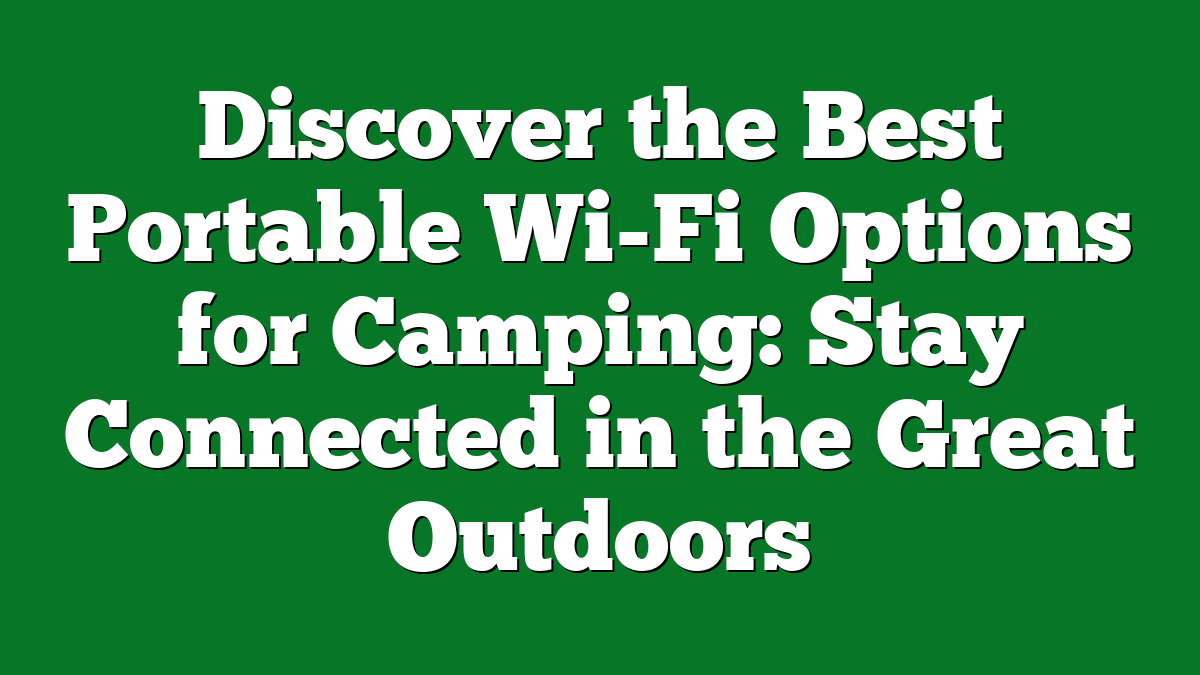Picture this: you’re surrounded by the beauty of nature, the crackling of a campfire, and the stars twinkling overhead. But then you realize you need to check in with family or share your adventures on social media. That’s where portable Wi-Fi comes in, making it easier to stay connected while enjoying the great outdoors.
Overview of Portable Wi-Fi for Camping
Portable Wi-Fi can transform the camping experience by offering a reliable connection to the outside world while I immerse myself in nature. Whether sharing photos of breathtaking sunsets on social media or checking in with family, staying connected enhances the adventure.
Various options exist for portable Wi-Fi, each catering to different needs and preferences. Mobile hotspots provide a versatile solution, allowing me to connect multiple devices while on the go. For remote camping spots where traditional Wi-Fi isn’t an option, satellite internet gets the job done. This setup ensures I can maintain a connection even in the most isolated locations.
Another choice includes Wi-Fi extenders, which boost signal strength when camping near established areas with public Wi-Fi networks, such as campgrounds. This option can be practical for connecting to nearby services while minimizing reliance on cell towers. Additionally, some RV parks and campgrounds offer Wi-Fi; having a backup plan ensures I’m ready no matter where I am.
Overall, incorporating portable Wi-Fi into my camping gear lineup makes for a well-rounded outdoor experience, blending exploration with connectivity. Each of these options provides various benefits, enhancing the ability to share my adventures with others while staying informed.
Top Portable Wi-Fi Devices
Staying connected while enjoying nature has never been easier. Here are my top picks for portable Wi-Fi devices that truly enhance any camping experience.
Device 1: Nighthawk M1 Mobile Hotspot
The Nighthawk M1 Mobile Hotspot features LTE connectivity, providing fast internet access for up to 20 devices simultaneously. Its long-lasting battery supports up to 24 hours of usage, ensuring I stay connected from sunrise to sunset. I appreciate the built-in Ethernet port, which allows me to connect to wired networks when available.
Device 2: Skyroam Solis X
The Skyroam Solis X offers global coverage with 4G LTE connectivity, perfect for my adventures across varied terrains. It supports up to 10 devices and includes a built-in power bank, keeping my gadgets charged while on the go. The one-day passes make it easy for me to control my data usage without commitment.
Device 3: Verizon Jetpack MiFi 8800L
The Verizon Jetpack MiFi 8800L gives me robust performance with its reliable LTE network. It supports up to 15 devices and features a responsive touchscreen for easy management. I value the device’s extended battery life, providing around 24 hours of connectivity, which is essential during longer camping trips.
Comparing Coverage and Speed
Staying connected while camping is key for safety and sharing experiences. Coverage and speed play a significant role in choosing the right portable Wi-Fi option. Both elements can deeply impact how I enjoy my outdoor adventures.
Factors Affecting Performance
- Technology Type: Mobile hotspots utilize cellular networks. Their performance depends on signal strength, which fluctuates in various terrains. Satellite internet works well in remote areas but often comes with latency issues.
- Terrain: Mountains, forests, and other obstacles can obstruct signals. These natural elements might reduce connectivity and speed, making it vital to check coverage maps before heading out.
- Device Specifications: Different devices support varying network bands and frequencies. Devices with dual-band capability can offer better speed and stability in different environments.
- User Load: The number of devices connected influences overall performance. More devices sharing the same connection often decrease speed, requiring consideration of my needs and the number of devices being used.
How to Choose the Right Coverage
- Assess Destination: Research the area I plan to camp in. Checking for available cellular towers and Wi-Fi service providers helps narrow down options for coverage.
- Consider Activation Plans: Various plans offer different coverage areas. If I’m exploring remote areas, a provider with extensive coverage will boost my chances of reliable connectivity.
- Evaluate Data Limits: Some devices come with monthly data caps. Understanding my usage habits—streaming music, checking maps, or sharing photos—helps me select a plan that fits my needs.
- Test Before You Go: If possible, evaluate the device’s performance in similar environments before my trip. Testing can help me identify potential issues and ensure I stay connected while exploring nature.
Additional Features to Consider
When choosing a portable Wi-Fi option for camping, several features enhance the overall experience.
- Battery Life: Look for devices with extended battery life. A reliable hotspot should provide at least 8–12 hours of use on a single charge. It caters to those long campfire evenings when connectivity matters.
- Data Plans: Consider the flexibility of data plans. Some devices offer pay-as-you-go options, while others require contracts. Picking a plan that suits your usage allows for better control over costs during the trip.
- Size and Portability: Compact devices fit easily into a backpack. A lightweight mobile hotspot is ideal for minimizing gear burden while maximizing convenience.
- Durability: Tough, water-resistant devices resist the elements. Choosing rugged gadgets ensures they withstand various outdoor conditions, from rainy mornings to dusty afternoons.
- User Capacity: Evaluate how many devices connect simultaneously. Opt for hotspots supporting multiple connections, especially when camping with friends and family. This feature allows everyone to share their adventures online.
- Compatibility: Verify that the portable Wi-Fi device works with your current gadgets. Ensuring compatibility with smartphones and tablets prevents connectivity headaches on the trail.
- Speed: Check for LTE or 5G support. Faster speeds improve streaming quality, enabling smooth sharing of videos and photos while exploring.
Focusing on these additional features ensures that my portable Wi-Fi option not only keeps me connected but also complements my camping lifestyle, enabling me to share my adventures while embracing the great outdoors.
Conclusion
Having portable Wi-Fi while camping really transforms the experience. It lets me stay connected without losing the beauty of nature. I can share my adventures in real-time or simply check in with loved ones.
Choosing the right device is key. I’ve learned that considering factors like coverage speed and battery life makes a big difference. With so many great options out there I feel confident I can find the perfect fit for my next trip.
Balancing technology with the great outdoors is totally possible. So whether I’m deep in the woods or at a scenic campsite I know I can enjoy both worlds. Happy camping and stay connected!











